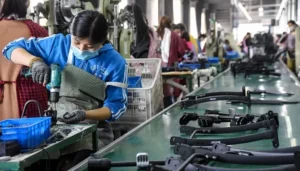China’s factory-gate inflation fell to a 17-month low in July, defying global cost pressures as domestic manufacturing weighed on demand for the raw material. However, the order for the raw material remained buoyant. As consumer price growth rose to a two-year high is too hard.
The National Bureau of Statistics (NBS) said on Wednesday that the producer price index (PPI) rose 4.2% year-on-year, up from 6.1% in June and analysts’ average forecast of 4.8%.
China’s producer price growth has slowed from a 26-year high in October last year, giving policymakers some leeway to stimulate the flagging economy while central banks aggressively slashed inflation with interest rate hikes. Scramble to reduce.
The Consumer Price Index (CPI) rose 2.7% from a year ago, the fastest pace since July 2020, but below forecast for a 2.9% gain.

The government has set an annual consumer inflation target of around 3%. At the same time, Premier Li Keqiang said last month that China would be able to keep the 2022 price hike below 3.5%, highlighting the need to stabilize prices and employment.
While China’s relatively benign inflation has been mainly driven by weak domestic demand, easing global price pressures, such as falling oil prices, also contributed to the July slowdown.
“Factory gate inflation will remain on the downside throughout the year amid further declines in commodity prices, lowering supply constraints and a higher basis for comparison,” said Jichun Huang, China financial expert at Capital Economics, in an exploration note.
In a sign of slowing momentum, the PPI fell 1.3% month-on-month for the first monthly decline since January, with the biggest fall in the price of metals and petrochemicals.
In annual terms, coal mining and washing industry prices rose 20.7 percent, down 10.7 percent from June, while the oil and gas extraction industry jumped 43.9%, down 10.5 percentage points, NBS said in a separate statement.
China’s last fall
Input prices fell in July last week in China’s official purchasing managers’ index, driven by falling energy and raw material costs and declining producer prices. read more
The world’s second-largest economy has slowed significantly and escaped contraction in the June quarter, weighed down by tighter COVID-19 controls, a distressed property market, and cautious consumer sentiment.
The People’s Bank of China (PBOC) said in a quarterly report on Wednesday that it will closely monitor domestic and external inflation changes while balancing economic growth and price stability.
Analysts at ANZ expect consumer prices to rise further in the coming months and hit around 4% in September. Still, full-year inflation could be at 2.4%.
In July, the main driver of consumer prices was food inflation, which rose 6.3% yearly, accelerating from a 2.9% increase in June.
Crop prices were driving broader food growth, which rose 20.2% year-on-year as production slowed, with a 6.0% drop in June.
However, the core CPI, which does not include volatile energy and food prices and is a better gauge of underlying inflation, remained soft, rising only 0.8% compared to a 1.0% increase in June.
While the PBOC is expected to keep monetary settings loose amid slowing growth, there are limits on how much it can ease policy due to concerns about capital outflows as the U.S. The Federal Reserve has forcefully increased interest rates.
The PBOC is therefore likely to rely on more targeted easing to support recovery, even as consumer inflation tests China’s 3% tolerance limit.
Bruce Pang, a chief economist at Jones Lang LaSalle, said this means interest rate cuts across the board are less likely, given the current global inflationary pressures and interest rate hikes in other major economies.
“In general, CPI expansion remains below the PBOC’s objective of around 3%, which gives it a strategic position,” HSBC financial expert Erin Shin said in a note.
“With continued uncertainty from COVID-19 clusters and weak sentiment in the property market, PBOC still needs to remain accommodating.”
















